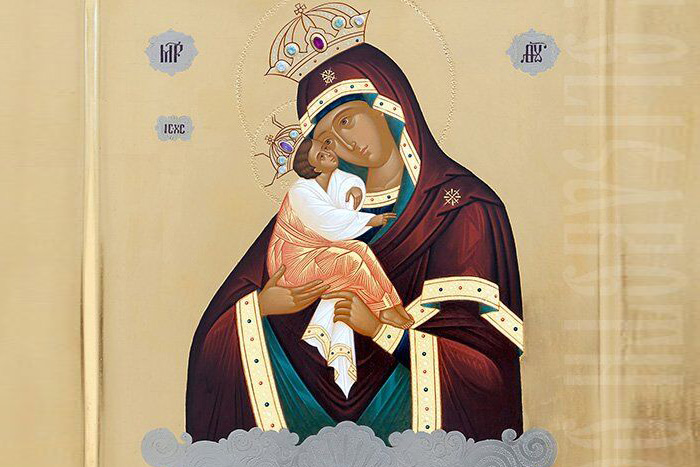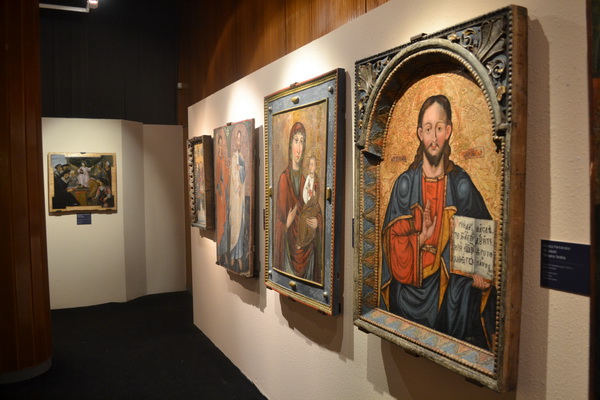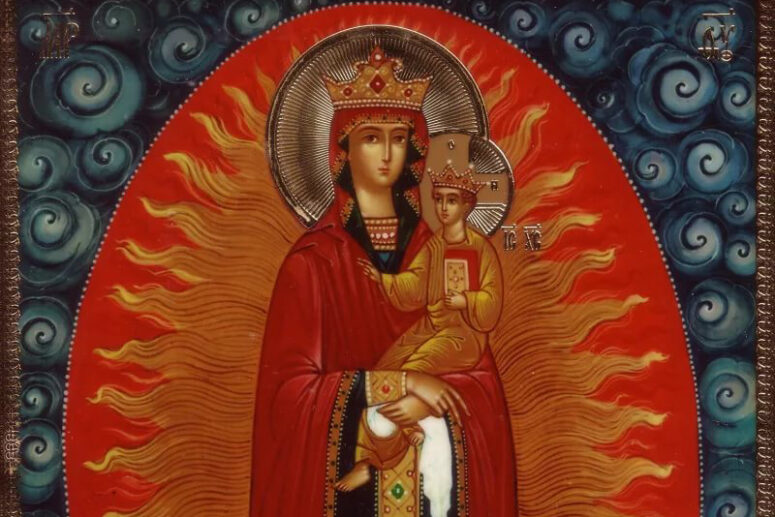
The image of the Mother of God “Graced of Heaven” belongs to the so-called akathist type and is quite rare and unusual. The iconography of this image has several different versions and even names. We would like to tell you about some of the existing images of this type and the wonderful stories associated with them.
Concept and Origin of the Icon
The image “Graced of Heaven” depicts the Queen of Heaven, as described by St John the Apostle in his Revelation. “A great sign appeared in heaven: a woman clothed with the sun, with the moon under her feet and a crown of twelve stars on her head.” (Rev. 12: 1). The woman in this case is interpreted by theologians as the personification of the holy church, which is why prayers for those fallen into disbelief or heresy are often offered before the images of the “Graced of Heaven”.
It is believed that this iconographic type originated in Germany in the 15th century, after which it became wide-spread in Western art. The possible prototype is the ancient image of the Mother of God “The Maid Shrouded in the Sun”. Unfortunately, the original of the “Graced of Heaven” icon has not survived, but some copies of it are revered as miraculous.
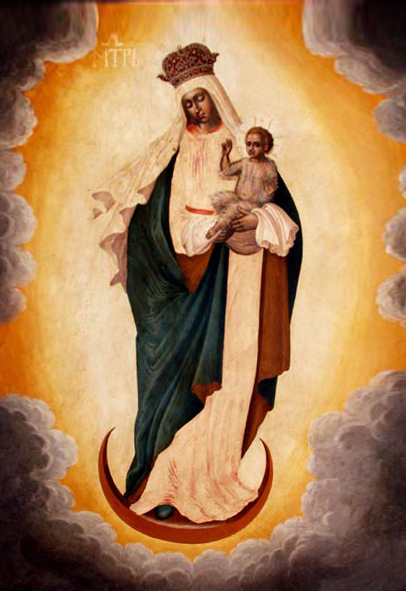
The image appeared on the territory of Russia in the 17th century and served as the basis for several iconographic versions, including the rare “Sunlit” type, the “Graced of Heaven” and the “What Name we Thee?” icon.
Ancient Russian Images
The earliest surviving Russian icon of the “Graced of Heaven”, was painted in the 1640s for the Church of the Holy Trinity in Nikitinki (Moscow). This image can be distinguished by the absent sun rays surrounding the Holy Virgin on other similar icons. The crescent under Her feet is also missing. St George of Choziba and St Andrew of Crete are depicted below standing in prayer before the Theotokos. These saints were the heavenly patrons of the two men who built the Trinity Church, and were depicted on the icon in their memory.
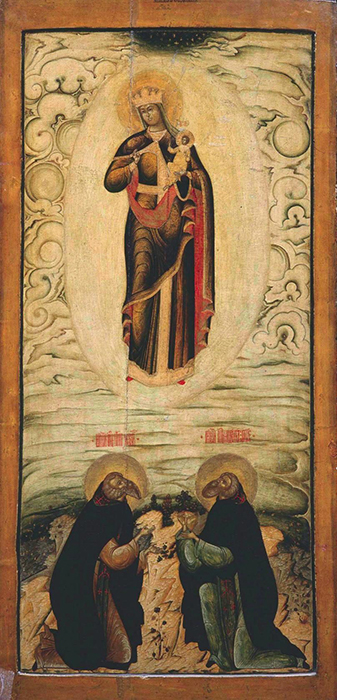
The most famous and revered in Russia is the icon of the Mother of God “What Name we Thee?” This image is believed to be a copy made in the 1680s from the original delivered to the Archangel Cathedral in Moscow Kremlin by order of Tsar Alexei Romanov. The icon received its new name from the opening lines of the prayer to the Mother of God, read during the 1st hour: “What name we thee, O thou who art full of grace? Heaven, for from thee hast dawned forth the Sun of Righteousness.” These lines are also written on the rays surrounding the face of the Holy Virgin on both sides.
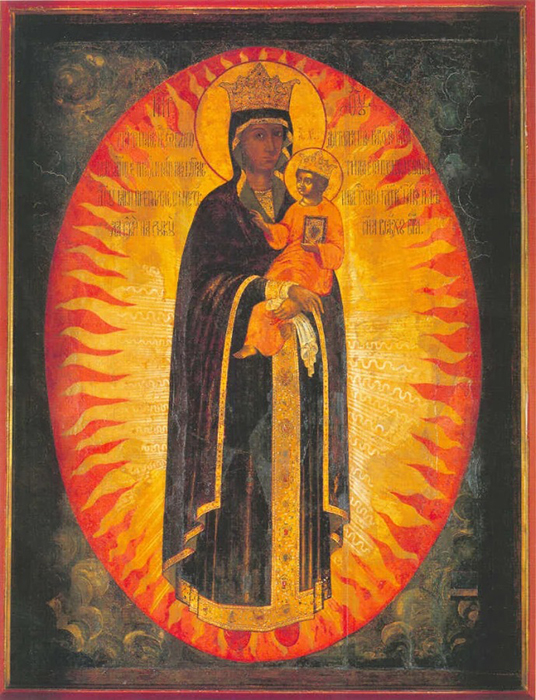
The profound veneration of the image by Orthodox believers began under Metropolitan Philaret Drozdov. By his decree of 1853 information began to be collected about the icon from the iconostasis of the Archangel Cathedral leading to it being recognized as miraculous.
Miracles
Healing. One Lutheran woman had been suffering from a serious illness for a long time when she saw the image of the Mother of God “Graced of Heaven” in a miraculous dream. Upon awakening, the woman sent her governess to order a prayer service for her health in front of this icon. The girl had been fulfilling the assignment for the following 6 weeks until the woman fully recovered and began to attend the church service herself.
A Mural Painting by Viktor Vasnetsov. In 1885, the famous Russian artist Viktor Vasnetsov was asked to paint the image of the Mother of God above the altar in the Vladimir Cathedral in Kiev. Vasnetsov turned down the offer due to his son’s illness. The works were then initiated under Professor Andrian Prakhov.
One spring evening, Vasnetsov was at the summer house with his family, when he was struck by the image of a woman with a baby in her arms. Delighted with the beauty of the blooming garden, the child was stretching out his hands to the artist. Inspired by his vision and deciding that he should use it as a prototype for the image at the Vladimir Cathedral, Vasnetsov sent Prakhov a telegram with his consent to participate in the work.
At the same time, another miracle happened in the temple, whose walls were plastered before painting. When Prakhov and his assistants went into the cathedral in the evening to check the work done, they saw an image showing through the still damp plaster layer. The Mother of God was standing in full growth, with the Infant in Her arms stretching out his arms, as if wishing to embrace the whole world. Before the plaster was dry and the wall turned pure white, the professor managed to sketch this image.
When Vasnetsov arrived and Prakhov showed him his sketch, the artist was amazed: it was identical to the sketches he had prepared. “This is God’s order.” he said, realizing the miracle. Two years later, Vasnetsov’s work was completed, and although this image was not entirely traditional, he was canonized with the name “Graced of Heaven”.

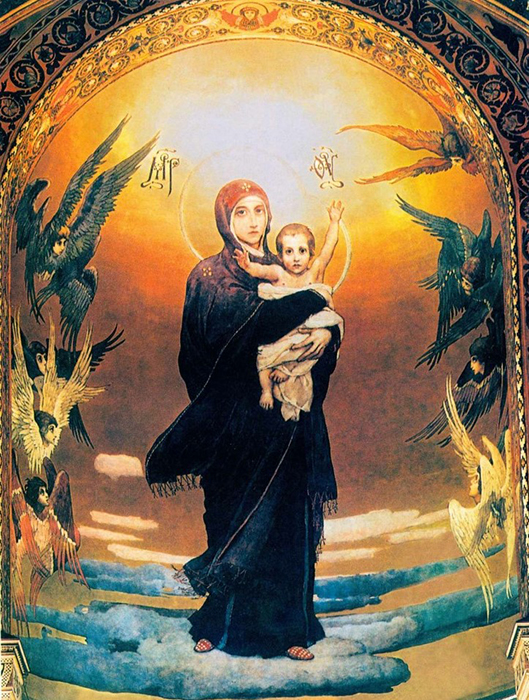
Renovating Icon. The locally revered copy of the image, located in the Church of the Life-Giving Trinity on Sparrow Hills (Moscow), was miraculously discovered in the 1960s. According to reliable stories, the blackened icon was found at the dump of the Moscow State University hostel. It turned out that students slept on it, placing it on the bed instead of a board. When the icon was brought to the temple, it was miraculously renewed after some time.
Protection on Battlefield. Those serving in the airborne troops greatly revere this image. Many field churches keep copies of it. The famous pilot and hero of the Great Patriotic War, Alexander Pokryshkin, was born on the feast day of this icon and often shared stories of the Mother of God keeping and protecting him in battles with Her invisible hand.
The memory of the icon is celebrated on March 19.


